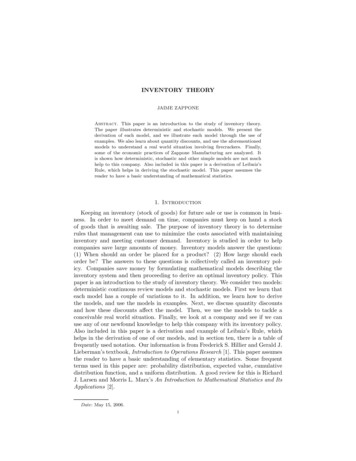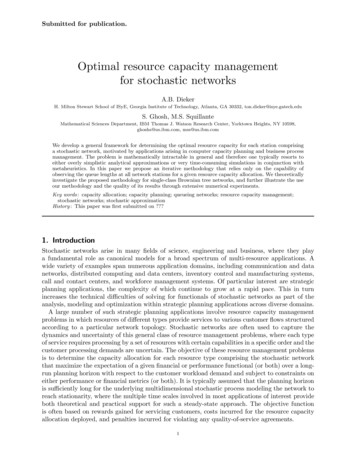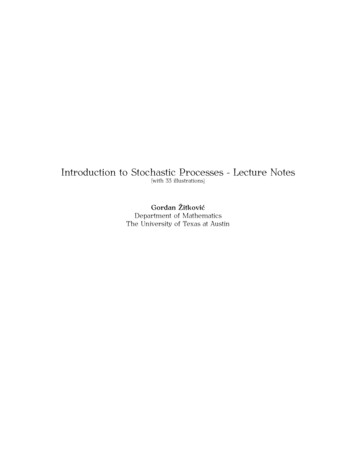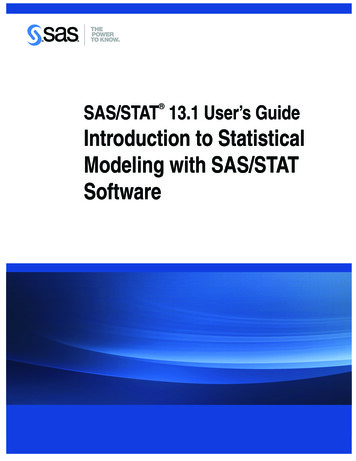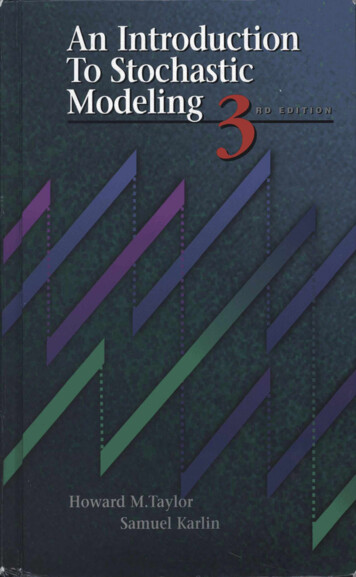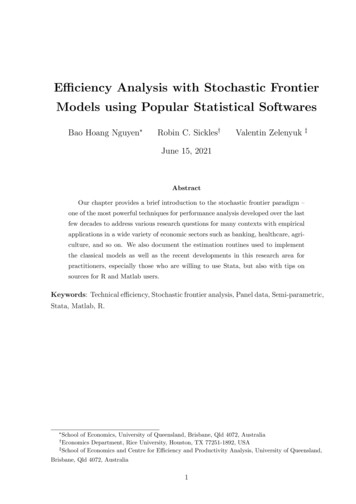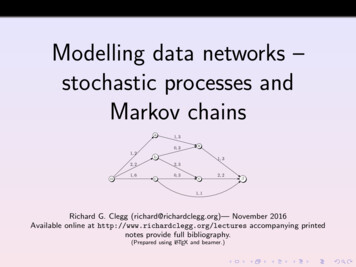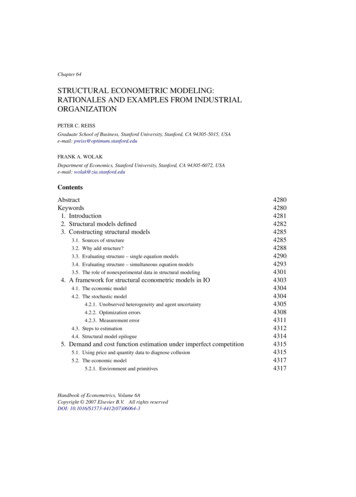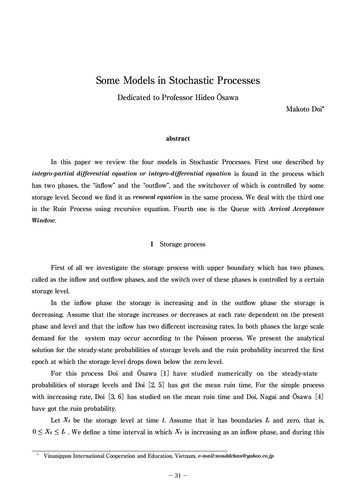
Transcription
Some Models in Stochastic ProcessesDedicated to Professor Hideo ŌsawaMakoto Doi*abstract*In this paper we review the four models in Stochastic Processes. First one described byintegro-partial differential equation or integro-differential equation is found in the process whichhas two phases, the “inflow” and the “outflow”, and the switchover of which is controlled by somestorage level. Second we find it as renewal equation in the same process. We deal with the third onein the Ruin Process using recursive equation. Fourth one is the Queue with Arrival AcceptanceWindow.1Storage processFirst of all we investigate the storage process with upper boundary which has two phases,called as the inflow and outflow phases, and the switch over of these phases is controlled by a certainstorage level.In the inflow phase the storage is increasing and in the outflow phase the storage isdecreasing. Assume that the storage increases or decreases at each rate dependent on the presentphase and level and that the inflow has two different increasing rates. In both phases the large scaledemand for thesystem may occur according to the Poisson process. We present the analyticalsolution for the steady-state probabilities of storage levels and the ruin probability incurred the firstepoch at which the storage level drops down below the zero level.For this process Doi and Ōsawa[1]have studied numerically on the steady-stateprobabilities of storage levels and Doi[2, 5]has got the mean ruin time. For the simple processwith increasing rate, Doi[3, 6]has studied on the mean ruin time and Doi, Nagai and Ōsawa[4]have got the ruin probability.Letbe the storage level at time t. Assume that it has boundaries L and zero, that is,. We define a time interval in which*is increasing as an inflow phase, and during thisVinanippon International Cooperation and Education, Vietnam. e-mail:mmddchan@yahoo.co.jp 31
RESEARCH BULLETINphaseforhas inflow ratesgiven thatNo.86forand. We also refer to a time interval in whicha rate(). Onceis decreasing as an outflow phase havingreaches the upper bound, it remains at the level in a certainperiod whose length is exponentially distributed with parameterthe phase changes to the outflow one andthatforgiven that. Immediately after this period,is controlled according to the outflow rategiven.Throughout these phases, the large scale demand for the system may occur according to thePoisson process, that is, the inter-occurrence time has an exponential distribution with parameterLet the amount of each demand has a distribution function.with the density functionhaving the finite mean.There are two cases for the switch over from the outflow phase to the inflow one. First, ifdecreases to the level l continuously, the phase instantaneously changes to the inflow one with rate. Second, ifdrops down into a domainbecause of a large scale demand for thesystem, the phase instantaneously changes to the inflow one with rate. In two cases statedabove the system can be switched without any loss of time. When the demand larger than thepresent level occurs, the storage becomes empty and the system is ruined. If a large scale demandhappens in the inflow phase, the inflow phase is continued without the case of large scale demanddropping down below the zero level. Once the ruin occurs,remains at level zero in a certainperiod according to an exponential distribution with parameter. Immediately after that period,the inflow phase begins.For this process, in the next section, we define the ruin probability and we constitute theintegro-differential equations.1.1Integro-partial differential equationsFor the model above, the states of the storage process are classified into four categories:*( ξ (t), X(t)) (1, x) if the process is in inflow phase and the storage level is,x at time t,( ξ (t), X(t)) (0, x) if the process is in outflow phase and the storage level isx at time t,( ξ (t), X(t)) 0.if the storage process is ruined at time t,( ξ (t), X(t)) L if the storage is full at time t,whereindicates the present phase.Thus we constitute the Markov process.Now, we define its probability distribution for 32 and:
Some Models in Stochastic Processes pt ( i, x ) P [(ξ (t ), X (t )) ( i, x )] , Pt (0) P [(ξ (t ), X (t )) 0] , Pt ( L ) P [(ξ (t ), X (t )) L] .Hence we have the following integro-partial differential equations with respect to.For pt (1, x ) (0 x L )L x pt (1, x ) p (1, x ) α1 (t ) t λ { pt (1, x ) pt (1, x y )dF ( y )}0 t x λ I(0,l ) ( x ){Pt ( L ) f ( L x ) L x0pt (0, x y )dF ( y )} , (1)and for pt (0, x ) ( l x L )L x pt (0, x ) p (0, x ) α0 ( x) t λ { pt (0, x ) Pt ( L ) f ( L x ) pt (0, x y ) dF( y )} 0 t x(2)where I0,l ( x ) 1 if x (0, l ); 0 otherwise.For the process with steady state we impose the condition on the process in the nextsubsection.1.2Integro-differential equationAssuming that,andexist, weconsider the steady state of this process.Hence we have the following integro-differential equations from (1) and (2).For p(1, x ) (0 x L )α1 (t )L xdp(1, x ) λ { p(1, x ) p(1, x y )dF ( y )}0dx λ {I(0,l ) ( x ){PL f ( L x ) L x0p(0, x y )dF ( y )}} , (3)and for p(0, x ) ( l x L ) α 0 ( x )L xdp(0, x ) λ { p(0, x ) PL f ( L x ) p(0, x y )dF ( y )} 0dx(4)To solve these equations, we need the boundary conditions:Lν λ { p(0, y ) p(1, y )}{1 F ( y )}dy λ PL {1 F ( L )}, 0 P00(ν L λ ) PL α1 ( L ) p(1, L ), (6)ν L PL α 0 ( L ) p(0, L ), p(0, l ) p(1, l ) L l0(5)(7){ p(0, l u ) p(1, l u )} f ( u )du PL f ( L l ). 33 (8)
RESEARCH BULLETINNote that we suppose1.3forNo.86.Analytical Solutions for the storage process}In this sub-section we present the analytical solutions for (3) and (4). First we have thefollowing Theorem concerning within the outflow phase.Theorem 1 If we takep(0, x ) B( x ) L x0foreδ0ythenis obtained as follows:B( x y )dM 0 ( y ) (9)whereB( x ) A0 ( x ) λ L xA0 ( x y ){1 F ( y )}dy , α 0 0λP F ( L x ), α0 LA0 ( x ) p(0, L ) H M0 (y)andn 12 n*0(10)(11)λ y δ ye {1 F ( y )}dy α 0 0( y ), H 0 ( y )(12)0is the unique solution of the equation 0(λ δ xe {1 F ( x )}dx 1. α0(13)0is the 2n-th fold convolution of.)Next we have the following Theorem concerning withTheorem 2 If we takeforp(1, x ) p(1, L ){1 L x0thenin the inflow phase.is obtained as follows:e dM1 ( y )} , (14)δ1 ywhere H M1 ( y )andn 1n*1( y ), H1 ( y )λ y δ ye {1 F ( y )}dy α1 0(15)1is the unique solution of the equation 0λ δ xe {1 F ( x )}dx 1. α1(16)1Next we havefor.Theorem 3 If we takep(1, x ) A1 ( x ) L x0foreδ2ythenA1 ( x y )dM 2 ( y ), whereA1 ( x ) p(1, l ) λP {F ( L l ) F ( L x )}α2 L 34 is obtained as follows:(17)
Some Models in Stochastic Processes H M2 (y)andλ l L{ p(0, u ) p(1, u )} f ( u v )dudv , α 2 x ln 1n*2( y ), H 2 ( y )(18)λ y δ ye {1 F ( y )}dy α 2 0(19)2is the unique solution of the equation 0λ δ xe {1 F ( x )}dx 1. α2(20)2To get the ruin probability, we need to obtain the probability L0whereby the following relation.{ p(0, x ) p(1, x )}dx PL P0 1, is expressed by(21)using the boundary condition.Finally we have the ruin probability by (5). In order to expressin (18) by, weuse (8) and (9). Thus we have p(1, l ) L l0{ p(0, l u ) p(1, l u )}dF ( u ) PL f ( L l ) λ A0 ( l ) α0 F ( y )}dy L l0eδ 0 y A0 ( l y )dM 0 ( y ) L l0A0 ( l y ){1 F ( y )}dy L l0(22)eδ 0 y A0 ( l y )dM 0 ( y ) λeδ y 0α 0 0L l0L ( l y )A0 ( l u ){1 F ( λ L l δ y L ( l y )e A0 ( l u ){1 F ( u )}dM 0 ( y ) 0α 0 0 .0Since the all probabilities are expressed by, we have the following theorem for the ruinprobability.Theorem 4 If we setp* (0, x ) P0p(0, x ) *p(1, x )and P0*, p (1, x ) , PLPLPLthen the ruin probability is obtained as P0λ PL L{I ( y ) p* (0, y ) p* (1, y )}{1 F ( y )}dy 1 F ( L ) , ν 0 0 ( l , L )(23)where 1L PL { p* (0, x ) p* (1, x )}dx P0* 1 . 0 1.4(24)The case of exponential demandsWe suppose the large scale demand occurs according to the Poisson distribution withparameterand its amount has the Exponential distribution with parameterIn this case the quantitiesand 35 are given by.
RESEARCH BULLETINNo.86λ dx ( i 1,2), αidM i( x)λλ αe2α 0 dM 0 ( x )(25)λ x αλ x e 0 e α 0 dx . x0Furthermore(26)are obtained from (13), (16) and (20), respectively.λδ i µ ( i 0,1,2).αiBy Theorem 1 and (7), we havep(0, x )for the outflow phaseas follows: ν LνLλ λ µ ( L x ) PL 1 F ( L x ) PL PL e ( L x ) Q( x ), αα0α0 α0µ 0 (27)where ν λ 1 δ ( L x )Q( x ) L 1 1 e 0 α 0 2α 0δ 0 δ 0 ( α 0 ( αλ 1 e2( λ α 0 µ ) λ α 0 µ λ 1 δ0 ( L x ) 1 λ e2α 02δ 0 α0µ λ1 ( α λ e2α 0 ( λ α 0 µ ) α 0 µ λ ( α e2α 0 λ( µ )( L x )0 ( L x )e µ ( L x ) µ )( L x )0 µ )( L x )0()α0 δ e2λ 0 ( L x ) e λ( L x )α0 . (28)for the inflow phase.λλ δ ( L x ) νL λ e 1 PL α1 α1δ1 α1δ1 ForA1 ( x ) p(1, l ) (29)1, λ 1 eδ 0 ( L x ) e µ ( L x ) 2α 0 λ ( µ )( L x ) 1 e µ ( L x ) 2 eδ 0 ( L x ) e α 0 2 PL 2α 0 Next, by Theorem 2 and (6), we havep(1, x ) λ 1α0 ( L x ) 1 2α 0 δ 0 λ α 0 µ )λλ)in (18) is obtained as follows:λ µ ( L x ) µ ( L l ) e(e) PLα2λ µ l µ x ν L λ 1 λ µ l µ L eδ L α l α e(e e ) e 1 (e e ) α2δ1 α1 µ α1δ1 1 36 λλ11L PL
Some Models in Stochastic Processes ν L 1 µ l1 1 µ l µ L e ( L l ) 1 ( e e ) PLα 0 µµ µ λ λ 1 µl µ L µL 1 ( e e ) e ( L l ) PLα0 α0µ µ L1 e µ L ( L l )2 e µ uQ( u )du ,l2 whereLe Q( u )du µul λ α αλ l αλ L 1 µ l µ L0 δ L e 0 e 0 e 0 e e 2α δ λ µ 0 0 ( ) 1 1 1 ν L 1 λ αδαα 0 0 0 µ 0 α (λα0 e2( λ α 0 µ ) λλ µ ) L0 αλ L αλ l 1 µ l µ L e 0 e 0 e e µ ( ) α0 1 1 ν L 1 λ αλαµαα 00 0 µ 0 1 µl µ L α0 λν L 1 µl ( L l )e 2 ( e e ) µ2α 02 δ 0 λ α 0 µ δ0 L l ( L l ) e µ L λ 1 e α0 e α0 e µ L ( L l ) 2 α0 λλ 1 α 0 α 0 l δ 0 L ( α 0 µ ) L e e 2 PL e 2α 0 λ λλ λ L λ ( L l ) α2e µ L( L l )2 0 2 e µ L e α 0 e α 0 2 . 22λ (30)For the second term of the right hand side of (17) we have the following. l x0eδ 2 y A1 ( x y )dyλ( eδα 2δ 22 ( l x ) 1) p(1, l ) e µ uQ( u )dul L ν λλ µl ν Lβ1 β L PL e β Lα2 α0 0α1 λ2( e(δα (δ 2 µ )22{(2 µ )( l x ) νν λ 1) e µ x L β 0 Lβ1 α1 α 0 β L e µ ( L x ) e µ ( L l ) )} P , where 37 L (31)
RESEARCH BULLETIN β01µe µl ( L l) 1 µ 1 1 µ ( e µ l e µ L ),λ 1 e δ 1 L α1 l α1 L e , e 1 α δ ( e µl e µ L ) µ δ1 1 1 λβ1 βLNo.86λλ 1 µl µ Lλ 1 µL µL2 1 α µ ( e e ) e ( L l ) e ( L l ) .µα0 20 2Renewal processIn the same process above we evaluate the right hand side of (4). First we note the followingrelation. p(0, x ) L x0p(0, x y ) f ( y )dyd L xp(0, x y ){1 F ( y )}dydx 0(32)Using this relation we rewrite (4) as:p(0, x ) A0 ( x ) λ L xp(0, x y ){1 F ( y )}dy .α 0 0(33)Since it is not the proper renewal function, we need the Tijms' method.Using δ 0 defined by (13), we define the distribution function: λ x δ 0 xe {1 F ( y )}dy ( x 0), H 0 ( x ) α 0 0 0 ( x 0). 2.1(34)Stabdard renewal equationNow we have the following standard renewal equation in Theorem1, Theorem 2 and Theorem 3.M i ( y ) H i1* ( y ) Hi (y) åHn 1 ò0( n 1)*(y)iM i ( y - x )dH i ( x ) ( i 1,2),and M 0 ( y ) H 02* ( y ) å H 0( 2 n 2)* ( y )n 1 H 02* ( y ) ò0 M 0 ( y - x )dH 0 ( x ). 38
Some Models in Stochastic ProcessesIt goes without saying that it is desirable to evaluate the convolution directly. Ifassumed to be the exponential distribution, we can evaluate the convolution easily.First, using, we haveHi ( x ) 1 - e- x i.And it is easily to getas follows: M i ( x ) å H ik * ( x )k 1 òx åH0 i ( k -1)*i( x - u)k 1xò0Let us denote by - uedu i{M i (x - u ) 1}ei- u idu .Laplace Transform ofmi ( s) . Then we have 1 . i s2By use of Inverse Transform, we have the following Proposition.Proposition 1Mi ( x) For x ( i 1,2). i, we need to evaluateG02* ( x ) Usingas follows:ö 2 æç 1 1 - xç - e - xe- x .2 ç 0 èç ø , we get the following.dH 02 k * ( x ) M0 ( x ) 2 02 2 -( xe 02ò0x0 )xdx ,{M 0 (x - u ) 1} ue- u 0du .In a similar fashion described above, we have the Proposition 2. 39 is
RESEARCH BULLETINNo.86Proposition 22 M0 ( x ) 1 - 0 x 1e x- .42 043Recursive equationIn this section, we consider the risk reserve process with exponential type claims and we findthe non-ruin probability depending on the initial state in finite time. Let us denote byreserve level at time, wherezero, the process ruins. The fluctuation oftheis called the risk reserve process. If the reserve level isis controlled by three elements : the claim inter-arrival time, the claim size and the premium rate. Let us assume that the claim inter-arrival time andthe claim size are independent and identically distributed random variables, respectively. We alsoassume the premium rate is a constant. In the same way of Mikosch [7] we introduce the notation :ìïU (t )ïïïï uïïïï X nïïí Tnïïïï Wnïïïïïïîï cthe reserve level at time t,the initial reserve level ( u U (0) 0),the n -th claim size,the n-th claim arrival time (T0 0),the claim inter-arrival timebetween ( n - 1)-th and n-th claim arrival times,: the premium rate,:::::where X n and Wn are independent.The total claim amount processand the premium incomeare defined asfollows :The total claim amount processis define asN (t )S (t ) å X n(t ³ 0),n 1whereis the claim number process defined byN (t ) max{n ³ 1 : Tn t} (t ³ 0).We define the premium income by I(t) ct, which is the accumulated income by timeTherefore, we obtain the expression of risk reserve process.as follows :U (t ) u I (t ) - S (t ), (t ³ 0).3.1Mathematical model for the ruin probabilityWe make a mathematical model to get the non-ruin probability in finite time (Doi[6]). 40
Some Models in Stochastic ProcessesIn the risk reserve process, since, the ruin can occur only at the timelinearly increases in the intervalsthe skeleton process of the risk reserve processthe skeleton process, we can express the eventclaim sizes{t 0{n ³1. We call the sequence(see Mikosch [7]). By use ofin terms of the inter-arrival times, the initial reserve level and the premium rate{ruin} inf U (t ) 0for some, the, as follows :} inf[u I (Tn ) - S (Tn )] 0}nùïì éïü ïíinf ê u - å ( X i - cWi )ú 0ïý.êún³1i 1ïïî ëïïþûNow, we defineZn X n - cWn , ( n ³ 1),Sn Z1 Zn , ( n ³ 1, S0 0).In this section, we propose R Ex Ex and R Ex Er models where R means the risk reserve process,the first Ex means that the claim inter-arrival timeand the next Ex means that the claim sizeEr:Erlang distribution with parameter3.2has an exponential distribution with ratehas an exponential distribution with rateand phase. In what follows, we omit the subscriptand.pdf. for the processWe find the probability distribution of random variablefor this model. First, let,which has the probability density function as follows :ìï - yïï e cfY ( y ) í cïïïîï0( y ³ 0)( y 0).Next, let us denoteìïï Z X - YíïïîV Y .Since X and Y are independent random variables, we obtain the joint probability density functionwith respect to Z and VfZV ( z, v ) e- ( z v ) c e- vc, 41
RESEARCH BULLETINNo.86where the domain of v isïìï 0 v íïîï-z v ( z ³ 0)( z 0).We obtain the probability density functionìï ïïe- zïï c g( z ) í ïï zïïecïïî c 3.3of Z as follows :( z ³ 0)(35)( z 0).Recursive equation for the non-ruin or ruin probabilitythe non-ruin probability that the risk reserve process does not ruin tillWe denote byn-th claim arrival time given the initial reserve level u and the premium rate c, that is,(36)rn( u, c ) P ( Z1 u, Z2 u - S1 , , Zn u - Sn-1(37) U (0) u,T1 T2 Tn ).Now we obtain the two Theorems for R Ex Ex model and R Ex Er model.Theorem 5 For R Ex Ex model, we obtain the probabilityas follows :r0 ( u, c ) 1,n-i-1nrn ( u, c ) rn-1 ( u, c ) -1 çæ ö -u n-1u i æ c ö e å K n ,n-i ççç i ! ççè c ø ççè c øi 0,( n ³ 1)(38)whereìï K n ,1 1,ïïïï K Kn , n -1 ,ï n,níïï K n ,l K n-1,l K n ,l -1 ,ïïïïïî K n ,l 0,( n ³ 1)( n ³ 2)( n ³ 3, 2 l n - 1)(39)( others ). Theorem 6 For R Ex Er model, we obtain the non-ruin probability in finite timeasfollows:r0( k ) ( u, c ) 1,nkn-1æ ö( u )i)rn( k ) ( u, c ) rn(-k 1) ( u, c ) - çç -n A k ( n-1)e-u å K n( k,kn, ( n ³ 1)içè c øi!i 0where 42 (40)
Some Models in Stochastic Processesìïïï k ïïcí ïï k ïï-1ïî A ,(41)andìï K ( k ) A k-1 ,ïï n ,1ïïmk- jïï K ( k ) ïï 1, m å A ,j 1ïí (k)ïï K n ,kn- j K n( k,k)( n-1) ,ïï ( k )ïï K n , m K n( k-)1, m K n( k, m) -1 ,ïïïï K n( k, m) 0,î( n ³ 1)(2 m k )(42)( n ³ 2, 1 j k )( n ³ 2, 2 m k( n - 1))( others ).The ruin probability for R Ex Ex model is given as follows:Theorem 7n - i -1npn ( u, c ) 1 çæ ö -u n-1u i æ c ö e å K n , n-i çç çç çè c øi ! ççè c øi 0( n ³ 1).(43)Also the ruin probability for R Ex Er ( phase k ) model:Theorem 8nkn -1æ ö( u )i)pn( k ) ( u, c ) çç -n A k ( n-1)e-u å K n( k,kn-içè c øi!i 04( n ³ 1).(44)Arrival acceptance windowIn this section, we consider a queue where there is an arrival acceptance window generatedthrough assigning arrival times to all customers. If a customer needs to receive the service, he has toarrive during his assigned window. A customer that cannot enter the system within the arrivalacceptance window is not offered the service and he must leave the system. The arrival acceptancewindow is generated through assigning arrival times to customers arbitrarily. At most one customercan be accepted to the queue in each window. Although the customer's arrival time is scheduled,actual one may be delayed. So we assume that the delay-arrival time is arbitrarily distributed. Andthe service time of accepted customer is assumed to be exponentially distributed. We refer thisqueueing system with one server as. Queueing models with the arrival acceptancewindow of this kind can be found in various situations (Doi, Chen and Ōsawa [8], Ōsawa, Doi, Chenand Shima [9]). Such a typical example is found in production systems of many factories and inscheduled arrival systems of medical clinics. 43
RESEARCH BULLETIN4.1No.86Mathematical modelWe define a mathematical model for thetime. The n, th window is generated atand the n, th customer is scheduled to enter the system during the time interval [where. Letbe the actual arrival time of theThe customer that does not enter the system by, i.e.,th customer where),., is refused to be offered theservice. That is, the customer must leave the system and never come back again. We assume thatdurations of windowsare independent and identically distributed random variables with adistribution functionarewhich has the finite meanwith a distribution function. We also assume delay-arrival timeshaving the finite meanacceptance probability of the window is. The service times of accepted customershave a common exponential distribution with the parameterLet. And the system has one server.be the number of customers in the system at timepoints for the system size processΞ . Note that the. We chooseand denoteas the embedded. The embedded processconstitutes a Markov chain.For the, Ōsawa et al.[9] have analyzed the system size process Ξ and obtainedthe necessary and sufficient conditions in which the limiting distribution of the process Ξ exists. Inorder to have the optimal arrival acceptance window size, we introduce costs to the queueingsystem. The system gets the benefit and incurs the waiting cost if a customer is offered the service.If a customer is not offered the service, the system incurs a lost-opportunity cost.4.2System size at scheduled timesLet us denote the transition probabilities for the process Ξ as :Pij P[ ( n 1) j ( n ) i], i, j ³ 0.Forwe obtain these as follows:Pij ò0 e- y ( y )i - je- y ( y )i 1- jB( y ) dA( y ) òB( y ) dA( y ), i ³ j ,0( i 1 - j )!( i - j )! Pj -1, j ò e- y B( y ) dA( y ),0where B( y ) 1 - B( y ).In the similar way, we have the transition probabilities for 44 and 0 as follows:
Some Models in Stochastic Processes Pi1 òB( y )0 ò0 P01 òò0 ò 0 ò0 yò ò0P00 òy 0 0e- t ( t )i-1 dB( )d e- ( y - ) dA( y ), i ³ 1,( i - 1)! e- t ( t )i-1dtB( y ) dA( y )( i - 1)!B(t )0 dB( )e- ( y - ) dA( y ),0yò0y0 Pi 0 òò òò0y ye- y ( y )i-1e- t ( t )i-1 dte- ( y -t ) dA( y )dA( y ) ò ò B(t )00( i - 1)!( i - 1)!e- t ( t )i-1 dt(1 - e- ( y -t ) ) dA( y )( i - 1)!e- t ( t )i-1 dtdB( )(1 - e- ( y- ) ) dA( y ), i ³ 1,( i - 1)!B( y ) dA( y ) ò0 0For any other cases, i.e.,òy0dB( )(1 - e- ( y - ) ) dA( y )., we haveWe obtain the transition probability matrix for the chain Ξ of theæçç P00ççç P10çççç P20P ççç P30ççççç çç çççè whereP01P11P21P31 0a0a1a2 0a0a1 0a0 0 type:ö øis defined byak ò 0 e- y ( y )k -1e- y ( y )kB( y )dA( y ) òB( y )dA( y ), k ³ 1,0k!( k - 1)! (45)a0 ò e- y B( y ) dA( y ).0type matrix, we can analyze the process Ξ .By use of the fundamental theory of theLet us denote the Laplace Stieltjes transform concerning the distributionas: a[s] ò e-sx dA( x ), s ³ 0.0We define the generating function for a sequence:by(45), then, for, we have Φ( z ) ò e- m (1-z ) y {B( y ) zB( y )} dA( y ).0We have the following. 45 (46)
RESEARCH BULLETINLemma 1 The equationNo.86has a unique solution such thatif and only if (47) ò B( y ) dA( y ) 1 , where / .0Throughout the paper, we denote asthe distribution functions F and I onthe solution described in the lemma. Let us introducedefined byF ( x ) 1 - e- (1- ) x ,I ( x ) 1.For convenience, we define a function [H ] ò0where ò0yd( B H )(t ) e- ( y -t ) dA( y ),is a distribution function on. Then we can have the limiting distribution of thesystem size as follows.Theorem 9 The process Ξ is positive recurrent if and only if.Moreover, under this condition, the limiting distribution of the system size process is given by k lim P[ n k]n ìï1 - ,( k 0),ïï ïíïïïïî (1 - ) k-1 , ( k ³ 1),where(48)is the unique solution defined as above and [I ] .ò F ( y )dA( y ) [I ] - [ F ]0From this theorem, we can obtain the following corollary.Corollary 10 The mean stationary system size L and its varianceL ,1 - (1 - )VL .(1 - )2 46 are given by
Some Models in Stochastic ProcessesAcknowledgementIt is the author's sincere gratitude to publish this paper as the dedication to Professor HideoŌsawa. Furthermore it is the great honor for the author to have the glorious co-research time around40 years with Professor Hideo Ōsawa.References[1] Doi, M. and Ōsawa, H., A storage process with non-constant inflow and outflow, Mathematical Modelling in Scienceand Technology, The Fourth International Conference, Pergamon Press, pp.305-310, 1983.[2] Doi, M., The expected ruin time for a storage process, Mathematica Japonica, Vol.51, No.1, pp.67-74, 2000.[3] Doi, M., The ruin time for a risk reserve process, Proceedings of the Conference CompStat 2002, pp.1-2, 2002.[4] Doi, M., Nagai, T. and Ōsawa, H., The ruin probability for a risk reserve process, Proceedings of the 4-th ARSConference of the IASC, pp.82-84, 2002.[5] Doi, M., Mean ruin time for the risk reserve process, Bulletin of Research Institute of Economic Science Nihon Univ.,Vol.37, pp.29-37, 2007.[6] Doi, M., The ruin probability and the ruin time for the risk reserve process, Bulletin of Research Institute ofEconomic Science Nihon Univ., Vol.48, pp.127-139, 2015.[7] Mikosch, T., Non-life insurance mathematics, Springer, Berlin, 2004.[8] Doi, M., Chen, Y. and Ōsawa, H., A queueing model in which arrival times are scheduled, Operations ResearchLetters, Vol.21, pp.249-252, 1997.[9] Ōsawa, H., Doi, M., Chen, Y., Shima, C., A queueing model with scheduled arrivals, International Journal ofInformation and Management Sciences, Vol.11, pp.49-58, 2000.[10] Neuts, M.F., Matrix Geometric Solutions in Stochastic Models, John Hopkins University Press, Baltimore, Maryland,1981. 47
31 Some Models in Stochastic Processes Dedicated to Professor Hideo Ōsawa Makoto Doi* abstract * In this paper we review the four models in Stochastic Processes.
